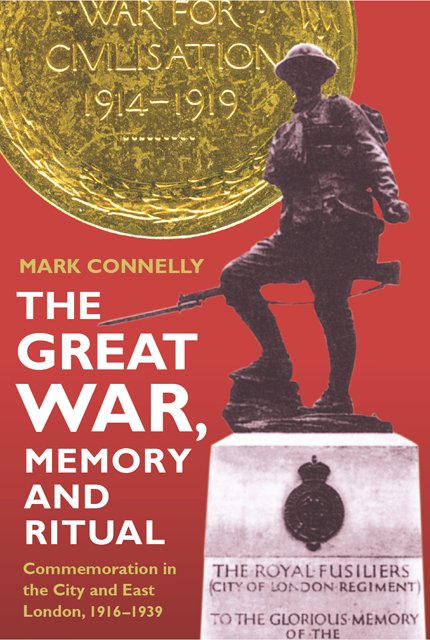1 - The City, East London and Metropolitan Essex
Published online by Cambridge University Press: 22 March 2023
Summary
In order to understand the nature of memorials erected to commemorate the Great War in the City, East London and into metropolitan Essex, the processes that led to their construction and the way in which Armistice Day developed and was celebrated it is first necessary to survey the district. It is important to have some grasp of the nature and psyche of the area as these traits shaped the form the memorials took, where they were sited and how much money could be raised and spent on the various projects.
Romford Urban District
Romford Urban District (since 1965 part of the London Borough of Havering) was formed in 1895 and provides the easternmost boundary of the London conurbation.1 Its growth was slightly different to the other suburban districts studied insofar as its expansion was steady rather than spectacular during the forty years between 1871 and the outbreak of the Great War: its real explosion came in the twenties and thirties. In 1871 the population stood at 8,239, by 1901 it was 13,915, in 1921 it had reached 19,442 and by 1931 it had climbed to 35,918. In 1914 it was therefore still a small town clinging to the eastern edge of London.
The economic character of the town was split between its ancient trades and newer industries and occupations. Romford was (and indeed still is) famed for its thriving market, which, lying in the shadow of the parish church of St Edward, dominated the town, supplying London with meat, grain and vegetables. Of similar fame was the Ind Coope brewery in the High Street; by 1908 it employed 480 workers and had laid down railway lines connecting it to Romford Great Eastern Railway station. It was the Great Eastern Railway that pulled Romford toward London: it not only linked the town to Liverpool Street, but was also a major local employer for the main stores department and the railway tarpaulins and sacks factory were based in the town.
The residential areas of Romford reflected the various characteristics of a suburban, small industrial and rural market town. By the 1880s a series of middle-class housing estates had been built. The most important of these was Mawney's estate, which took up a large square of land and rapidly acquired its own character, due to its relatively isolated nature at the northern point of the town.
- Type
- Chapter
- Information
- The Great War, Memory and RitualCommemoration in the City and East London, 1916-1939, pp. 13 - 24Publisher: Boydell & BrewerPrint publication year: 2001

